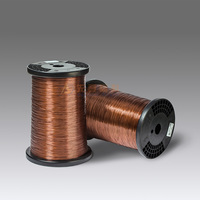About The Characteristics Of Enameled Aluminum Wire
-
Due to the inherent difference of conductor materials, the mechanical, electrical and chemical properties of enameled aluminum wire are different from those of copper magnet wire. These differences are reflected in certain test procedures and/or performance requirements of aluminum magnet wires, such as elongation, adhesion and flexibility, thermal shock, scratch resistance, continuity, and heat resistance.
Enameled wire is a wire coated with a thin insulating layer to prevent short-circuiting the wire surface when it is wound into a coil. When current flows through the coil, magnetic flux is generated. It is mainly used in the construction of motors, electromagnets, transformers and inductors. In order to easily manufacture inductive components, such as transformers and inductors, most of these wires can be soldered.
Enameled aluminum wire is classified according to its diameter (AWG specification number or mm), temperature class and insulation thickness. A thicker insulating layer leads to a higher breakdown voltage (BDV). Common temperature classes are 130, 155, 180 and 200°C. Common shapes are divided into Rectangular Enameled Aluminum Wire and round enameled aluminum wire.

